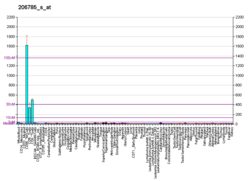Top Qs
Timeline
Chat
Perspective
KLRC2
Protein-coding gene in humans From Wikipedia, the free encyclopedia
Remove ads
NKG2-C type II integral membrane protein or NKG2C is a protein that in humans is encoded by the KLRC2 gene.[3][4] It is also known as or cluster of differentiation 159c (CD159c).
Remove ads
Function
Natural killer (NK) cells are lymphocytes that can mediate lysis of certain tumor cells and virus-infected cells without previous activation. They can also regulate specific humoral and cell-mediated immunity. NK cells preferentially express several calcium-dependent (C-type) lectins, which have been implicated in the regulation of NK cell function. The group, designated KLRC (NKG2) are expressed primarily in natural killer (NK) cells and encodes a family of transmembrane proteins characterized by a type II membrane orientation (extracellular C terminus) and the presence of a C-type lectin domain. The KLRC (NKG2) gene family is located within the NK complex, a region that contains several C-type lectin genes preferentially expressed on NK cells. KLRC2 alternative splice variants have been described but their full-length nature has not been determined.[4]
Remove ads
Interactions
KLRC2 has been shown to interact and form dimers with CD94.[5][6] The CD94/NKG2C heterodimer can bind to HLA-E[7][8] and this binding leads to NK cells activation.
During infection with human cytomegalovirus, peptides derived from the virus are presented on HLA-E and natural killer cells that express the CD94/NKG2C receptor can specifically recognise the virus peptides. This recognition leads to activation, expansion, and differentiation of adaptive NK cells.[9]
Remove ads
See also
References
Further reading
Wikiwand - on
Seamless Wikipedia browsing. On steroids.
Remove ads



